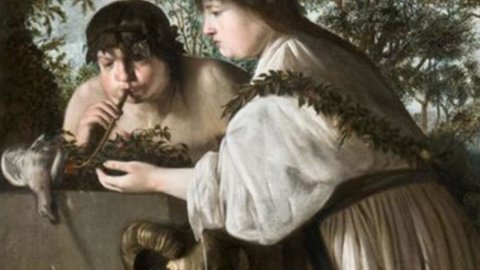The set of paintings by Paulus Bor, a painter originally from Amersfoort (Netherlands) who lived in the 30th century, includes less than XNUMX works. From today an oil on canvas entitled Scene of sacrifice becomes part of the collections of the Uffizi Gallery, thanks to the donation of the Amici degli Uffizi Association.
After today's presentation in the Aula di San Pier Scheraggio, the painting will be visible in Room 54 of the Uffizi (dedicated to the XNUMXth century Dutch Painters of Haarlem, Utrecht), on the Noble Floor of Vasari's building.
"Since the Uffizi Gallery has been included ad interim in the Institutes of the Regional Secretariat - writes Paola Grifoni, Regional Secretary of MiBACT for Tuscany - I have been able to verify the intense programming of events relating to the entire chronological span of the museum's collections, from antiquity to the present day: exhibitions, rearrangements, conferences, donations. Precisely among these, the one – generously offered by the Friends of the Uffizi – of this precious painting by Paulus Bor, a very rare artist of high poetic quality, which enriches the new rooms of foreign painters, inaugurated in December 2011, seems to me to be particularly remarkable”.
“Bor's canvas, with an unusual (not to say extravagant) theme and eccentric layout – adds Antonio Natali, Director of the Uffizi Gallery – combines a vision of a typically Nordic village with memories of Roman antiquities, known and loved by the painter in a stay in Rome between 1623 and 1626. He too, like many of his countrymen, must have moved to the city to study the relics of a heroic past learned from books and to get to know the masterpieces of the great masters from the early sixteenth century; but then, he too, will have been dazzled by the luministic innovations of Caravaggio and his numerous disciples. However, the peculiarity of Bor's style will become clearer when his canvas is exhibited in the room of the Dutch painters in Utrecht, where it was thought it could find a suitable place”.
"It is with particular pleasure that the Amici degli Uffizi present this further and important acquisition, which allows us to enrich the collection of our museum with a rare painting by Paulus Bor, Scene of sacrifice - underlined Maria Vittoria Rimbotti, President of the Amici degli Uffizi - . The Dutch artist, little known to non-experts, lived in Rome and it is said that his painting denotes a typical style of the Caravaggisti with Rembrandt cues, with representations of unusual and enigmatic subjects. In addition to being close to the Uffizi as patrons for the restorations and interventions necessary to protect the needs of the Gallery, our efforts in these difficult times have always been open to the need for completeness and documentation which precisely characterize the growth of the Uffizi collections".
It should be noted that for the occasion the CentroDi produced a publication in the series “Studies and research. The leaflets” dedicated to Bor's work donated to the Gallery.
BRIEF NOTES ON THE WORK
Paulus Bor (Amersfoort, Netherlands, c. 1601-1669)
Sacrifice scene
1635-1640
Oil on canvas, 89,5 x 67,7 cm
The present work shows a female figure wrapped in a mantle covered with flowers, who is about to perform the sacrifice of a bird, placed on an altar. Assisting the woman is a young man with a bare torso, blowing out the small flame that is developing in the leaves. The subject does not appear to be attributable to a precise literary source and should rather be qualified as a very personal reinterpretation of a scene of classic sacrifice in a natural setting. The young man with his head surrounded by a laurel wreath almost certainly represents a shepherd, just as the bird should be a dove, dear to Venus and a symbol of love. In the invention, the main protagonist remains the figure of the sorceress: with her absorbed and pensive face, and her calm gestures, she manages to give an intimately solemn atmosphere to the ritual. The physiognomy of the woman is typical of Bor: a full and soft face, a short neck, long loose hats and a dreamy expression.
The Uffizi canvas represents an important addition to Paulus Bor's small corpus of paintings. In putting together the elements of the composition, the artist pays particular attention to the distribution of shapes on the surface – wide and not so wide, smooth and not so smooth – instead of worrying about the spatial construction. The slight silvery tone of the painting is especially striking, which distinguishes almost all the painter's works. Bor's more properly pictorial vocation determines the happily transparent rendering of the sorceress' mantle, but also the more precise rendering of the ram's skull. The application of the pictorial material becomes more pasty on the fleshy face of the young shepherd blowing on the fire. In this detail we find an echo of the style of the Caravaggio painters of the Utrecht school.





